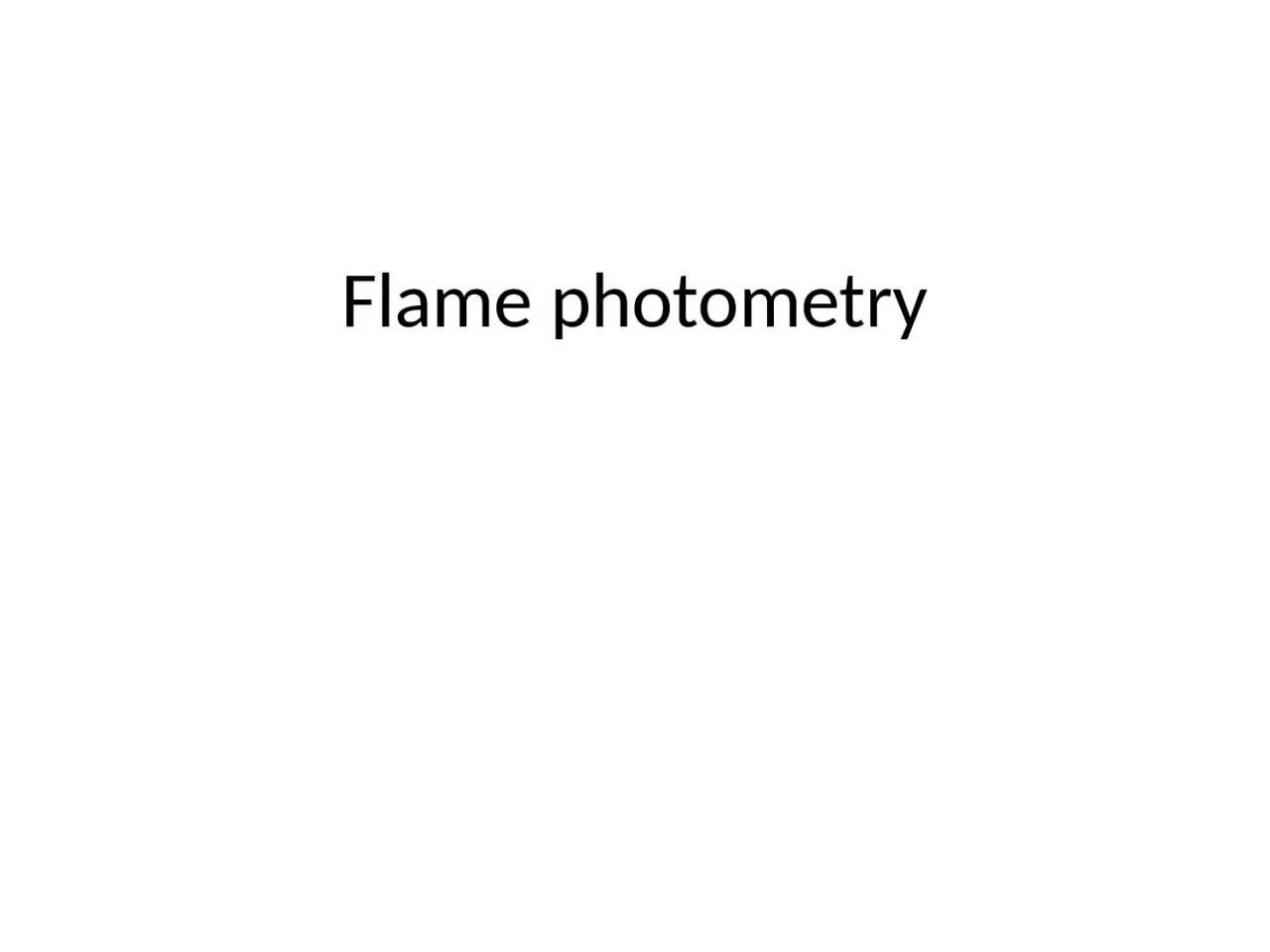

Principle 1flame photometry a branch of atomic spectroscopy is used for determining the concentration of certain metal ions such as sodium potassium lithium calcium Cesium etc ID: 1022385
Download Presentation The PPT/PDF document "Flame photometry Introduction" is the property of its rightful owner. Permission is granted to download and print the materials on this web site for personal, non-commercial use only, and to display it on your personal computer provided you do not modify the materials and that you retain all copyright notices contained in the materials. By downloading content from our website, you accept the terms of this agreement.
1. Flame photometry
2. IntroductionPrinciple :1-flame photometry, a branch of atomic spectroscopy is used for determining the concentration of certain metal ions such as sodium, potassium, lithium, calcium, Cesium, etc.2-The basis of flame photometric working is that, the types of metals are dissociated due to the thermal energy provided by the flame source. Due to this thermal excitation, some of the atoms are excited to a higher energy level where they are not stable.
3. 3-The subsequent loss of energy will result in the movement of excited atoms to the low energy ground state with emission of some radiations as a wavelengths .The emitted wavelengths are specific for specific elements.
4.
5. 1. The solution containing metal to be measure is first aspirated into the burner.2. The solvent then evaporated leaving fine divided solid particles.3. This solid particles move towards the flame, where the gaseous atoms and ions are produced.
6. 4. The ions absorb the energy from the flame and excited to high energy levels.5. When the atoms return to the ground state radiation of the characteristic element is emitted.6. The intensity of emitted light is related to the concentration of the element.
7.
8. FP Components1- Flame : A burner that provides flame and can be maintained in a constant form and at a constant temperature. 2- Nebuliser and mixing chamber: Helps to transport the homogeneous solution of the substance into the flame at a steady rate. 3- Monochromator : helps in isolating the wavelength to be measured from that of any other extraneous emissions.
9. 4. Photo detector: Detect the emitted light and measure the intensity of radiation emitted by the flame. That is, the emitted radiation is converted to an electrical signal with the help of photo detector. The produced electrical signals are directly proportional to the intensity of light.
10.
11. Burner used in FP should have the following properties:The flame should have ability to evaporate the solvent to give a residue(deposit)- It should convert this residue to gases state atom and finally into individual atomsFlame (burner)
12. The effect of flame depend on the temperature of flame and this temperature can be monitored by following method:Fuel to air ratioType of solvent for preparing sample solution Amount of solvent which is entering to flameType of burner used in FP
13. Flame (burner)Flame photometry employs a variety of fuels mainly air, oxygen or nitrous oxide (N2O) as oxidant. Burners are of two types:Total Consumption Burner and Premix or Laminar flow Burner.
14. Desolvation: The liquid solvent is evaporated, and the metal particles are dehydrated by the flameVapourisation: The sample vaporises to a gas .Atomization: Reduction of metal ions in the solvent to metal atoms by the flame heat.The various processes in the flame are discussed below:
15. Excitation: The electrostatic force of attraction between the electrons and nucleus of the atom helps them to absorb a particular amount of energy. The atoms then jump to the exited energy state.Emission process: Since the higher energy state is unstable the atoms jump back to the stable low energy state with the emission of energy in the form of radiation of characteristic wavelength, which is measured by the photo detector.
16. Types of FP1- Direct type: Standard solution of Na & K are atomised or aspirated into flame to provide a series of meter readings in which our unknown is going to compared with.
17. Direct type disadvantages1- Any minor fluctuations in air, gas pressure might change response of instrument and then cause errors.2- Separate analyses and sometimes separate solutions must be made for Na and K.
18. 2- Internal standard method: Another element (Li) is added to all standards, blanks and unknowns in equal concentration. This element has a criteria of :* high emission intensity.* Is absent from biological fluid.
19. Applications1- Determine the availability of alkali and alkaline earth metals which are critical for soil cultivation. 2- In agriculture, the fertilizer requirement of the soil is analyzed by flame test analysis of the soil.
20. 3- In clinical field, Na+ and K+ ions in body fluids, muscles and heart can be determined by diluting the blood serum and aspiration into the flame. 4- Analysis of soft drinks, fruit juices and alcoholic beverages can also be analyzed by using flame photometry.
21. Advantages: 1.Simple quantitative analytical test based on the flame analysis.2.Inexpensive.3.The determination of elements such as alkali and alkaline earth metals is performed easily with most reliable and convenient methods.4.Quite quick, convenient, and selective and sensitive to even parts per million (ppm) to parts per billion (ppb) range.
22. FP suffer the same level of interferences as AAS from:1- Anion due to complexation (chemical interference).2- Matrix interference.3- Burner interference.4- Ionisation interference. 5- emission interference.
23. limitationsAlteration of light emission because of altered flame temp.It needs perfect control of flame temperature.Interference by other elements is not easy to be eliminatedHeavy and transition metals , the number of absorption and emission lines is enormous and the spectra are complexInadequate selectivity of WL. Differences in viscosity between standards and sample.
24. Advantages of AAS over FP1- Sensitivity. 2- Applicability.3- Smaller flame effect.4- Less interference from other cations.
25. AAS Vs PF